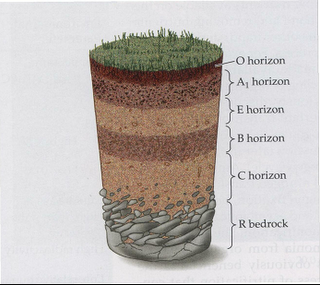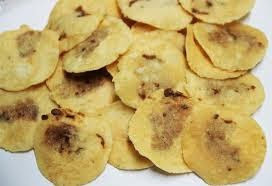Soil Klassification
One
soil classification system that has been developed United States known
as: Soil Taxonomy (USDA, 1975; Satff Soil Survey, 1999; 2003). This classification system uses six (6) kateori, namely:1. Order (Order)2. suborder (Sub-Order)3. Group (Great group)4. Sub-group (subgroup)5. Family (Family)6. Series.Distinguishing characteristics Each Category:Category Order Land:Order of the soil horizon are distinguished by the presence or absence identifier and type (nature) of the identifier horizon.For example: a land that has argillic horizon and berkejenuhan bases greater than 35% belong to the order Alfisol. While other lands who have argillic horizon but berkejenuhan base of less than 35% belong to the order Ultisol.Examples of nomenclature ground Order categories:Ultisol.(Note: the ground has argillic horizon and berkejenuhan base less than 35% and has developed ground-level end = Ultus). Name order Ultisol on nomenclature for the sub category of the order
will be used the abbreviation of the name of the order, namely: Ult is
the abbreviation of the order Ultisol).Category Sub-Soil order:Sub-soil
orders are distinguished by genetic differences in the soil, for
example: the presence or absence of soil properties related to the
effect of: (1) water, (2) moisture regime, (3) the main iduk materials,
and (4) of vegetation. While differentiating sub-orders for land order histosol (organic
soil) is the rate of decay of organic matter constituent: fibris, Hemis,
and safris.Examples of nomenclature ground Order Sub category:Udult.(Note:
the ground berordo Ultisol which has a regime of humidity that is
always moist and never dry called: Udus, so used abbreviations
identifier of humidity are: Ud. The word Ud added to the name of the
Order tanahUltisol abbreviated Ult, being said to nomenclature order sub-categories, namely: Udult).Categories Great Group Land:Great
Group soil distinguished by differences: (1) type, (2) the level of
development, (3) the composition of the horizon, (4) in base saturation,
(5) regi temperature, and (6) humidity, and (7) whether there is
any-layer another layer identifier, such as: plinthite, fragipan, and duripan.Examples of nomenclature soil Great Group categories:Fragiudult.(Description: The land has a fragile layer padas called Fragipan, so
that added to the abbreviation of the word Fragipan, namely: FRAGI. The
word FRAGI added to the Sub Order: Udult, being said to nomenclature
great group categories, namely: Fragiudult)Category Sub Group Land:Sub
Group soil distinguished by: (1) the nature of the core of a great
group and named Typic, (2) soil properties transition to: (a) great
group of others, (b) sub other orders, and (c) other orders, and (d) to not soil.Examples of nomenclature land category Sub Group:Aquic Fragiudult.(Caption: The land has properties transition to sub order Aquult
because sometimes the influence of water, thus including the sub group
Aquic).Category Family Land:Family land is distinguished by soil properties that are important for
agriculture or engineering, including soil characteristics: (1) the
grain size distribution, (2) the composition of clay minerals, (3) the
temperature regime at a depth of 50 cm.Examples of land in the category nomenclature Family:Aquic Fragiudult, fine clayey, kaolinitic, isohipertermik.(Caption:
Identifier Family of land are: (1) the structure of large grains is
clayey fine, (2) the composition of clay minerals is dominated by clay
mineral kaolinite, (3) the regime of temperature is isohipertermik, the
soil temperature is over 22 degrees celsius with soil temperature difference summer with winter less than 5 degrees celsius).Soil Series categories:Soil
series are distinguished by: (1) the type and composition of the
horizon, (2) the color, (3) texture, (4) the structure, (5) consistency,
(6) reaction of soil from each horizon, (7) properties other soil chemistry, and (8) the properties of each mineral horizon. Determination of first category Seri land can be used as a location name identifier of the series.Examples of nomenclature of land in the category Series:Aquic Fragiudult, fine clayey, kaolinitic, isohipertermik, Sitiung.(Note: Sitiung first discovered the site of the ground in the Series category).The soil classification system different from the system that already exists. This classification system has a privilege, especially in terms of:1. Naming or Nomenclature or naming conventions.2. Definitions horizon identifier.3. Some properties of soil classification identifier latest
lainnya.Sistem provide Naming Land based on the main properties of the
soil.According Hardjowigeno (1992) there are 10 orders of land in the USDA
Soil Taxonomy system in 1975, accompanied by the name stands for the
order, is as berikiut:1. Alfisol -> abbreviated: Alf2. Aridisol -> abbreviated: Id3. Entisol -> abbreviated: Ent4. Histosol -> abbreviated: Ist5. Inceptisol -> abbreviated: Ept6. Mollisol -> abbreviated: Oll7. Oxisol -> abbreviated: Ox8. Spodosol -> abbreviated: Od9. Ultisol -> abbreviated: Ult10. Vertisol -> abbreviated: ErtFurthermore, soil classification system has grown from 10 order pata 1975 to 12 orders in 2003 (Rayes, 2007). The twelve orders are differentiated by:(1) whether or not the identifier horizon,(2) the type of identifier horizon, and(3) other soil properties that are the result of soil formation processes, include:3.1 special identifier, and3.2 other identifier.Horizon identifier consists of two parts:(A) above the horizon (surface) or epipedon, and(B) under or endopedon horizon.Epipedon or horizon above / penciri surface divided into eight categories (Soil Survey Staff, 2003), namely:(A) epipedon mollik,(B) epipedon umbrik,(C) epipedon okrik,(D) epipedon histik,(E) epipedon melanik,(F) epipedon anthropic,(G) epipedon folistik, and(H) epipedon plagen.Endopedon or below the horizon identifier is divided into 13 (Soil Survey Satff, 2003), yiatu:(A) argillic horizon,(B) kambik horizon,(C) kandik horizon,(D) Classical horizon,(E) oxic horizon,(F) gipsik horizon,(G) petrokalsik horizon,(H) natrik horizon,(I) plakik horizon,(J) spodik horizon,(K) sulfuric horizon,(L) albik horizon.Some Properties of Special Identifier, is:(A) concretions,(B) padas (pan),(C) fraipan, (duripan),(D) Plintit,(E) slickenside,(F) the lining of clay,(G) contact lithic,(H) contact paralithik.Some Properties Other Identifier, is:(A) the soil temperature regimes,(B) soil moisture regime, and(C) soil properties Andik.Soil temperature regime classified into 3 categories, namely:(A) mesic: the ground temperature annual average 8oc s / d 15oC.(B) thermic: the ground temperature annual average 15oC s / d 22oC.(C) Hyperthermic: the ground temperature annual average> 22oC.The term iso (iso-mesic, iso-thermic, iso-Hyperthermic) is used to
indicate differences in soil temperatures average summer and winter
<> soil moisture regime is distinguished in four categories,
namely:(A) aquic: almost always water-saturated soil, resulting in the
reduction and demonstrated by their rusty with low chroma (chroma
<>Alfisol:The
land that belong to the order Alfisol the soils are clay accumulation
in the lower horizon (argillic horizon there) and has a high base
saturation of more than 35% at a depth of 180 cm from the ground. Buried in the clay below the horizon comes from the horizon on it and washed down with water movement. Matching with the old classification system is included Mediterranean
lands Red Yellow Latosol, sometimes also Podzolik Red Yellow.Aridisol:The land that belong to the order Aridisol are lands that have arid soil moisture (very dry). Epipedon have ochrik, sometimes with another identifier horizon. Matching with the old classification is included Desert Soil.Entisol:The land that belong to the order Entisol the soils are very young are beginning a new level in the development. There is no horizon other identifiers except epipedon ochrik, albik or histik. The word Ent means recent or new. Matching with the old classification system is included Alluvial soil or Regosol.Histosol:The
land that belong to the order Histosol the soils with organic matter
content of more than 20% (for a sand-textured soils) or more than 30%
(for clay soils). Layers containing high organic matter is thicker than 40 cm. Histos word meaning plant tissue. Matching with the old classification system is included Organic soil or Organosol.Inceptisol:The land that belong to the order Inceptisol a young land, but more developed than Entisol. Inceptisol word comes from the word meaning Inceptum starters. Generally have kambik horizon. This land is not developed further, so that most of the soil is quite fertile. Matching with the old classification system is included alluvial soil, Andosol, Regosol, Gleihumus, etc.Mollisol:The
land that belong to the order Mollisol the soil with a thick epipedon
more than 18 cm black (dark), organic matter content of more than 1%,
base saturation of more than 50%. Aggregation of good soil, so the soil is not hard when dry. The word is derived from the word Mollis Mollisol which means soft. Matching with the old calcified system is included Chernozem soil, Brunize4m, Rendzina, etc.Oxisol:The land that belong to the order Oxisol an old land so easily weathered minerals is low. High clay content but inactive so that the cation exchange capacity (CEC) is low, at less than 16 me / 100 g clay. Many contain iron oxides or oxide Al. Based on observations in the field, shows the land boundaries were not clear horizon. Matching with the old classification system is included ground Latosol
(Red Latosol Latosol Red & Yellow), lateritic, or Podzolik Red
Yellow.Spodosol:The
land that belong to the order Spodosol is a land with a lower horizon
was no accumulation of Fe and Al oxides and humus (horizon spodik) was,
dilapisan on the horizon there eluviasi (laundering) pale (albic). Matching with the old classification system is included Podzol ground.Ultisol:The
land that belong to the order Ultisol the lands accumulation of clay on
the bottom horizon, acidic, base saturation at a depth of 180 cm from
the soil surface is less than 35%. Matching with the old classification system is included ground Podzolik Red Yellow Latosol, and Hidromorf Gray.Vertisol:Which
belong to the order Vertisol soil is soil with a high clay content
(over 30%) in the entire horizon, has the properties expands and
contracts. If the soil dry soil constricts so chapped and hard. If wet fluffy and sticky. Matching with the old classification system is included ground Grumusol or Margalit.Matching Multiple Land NameMatching name of the land between Soil Taxonomy 1999 (A) with a
variety of other soil classification system, namely: FAO Unesco 1974
(B), Dudal and Supraptohardjo 1957 (C) and Thorp and Smith 1949 (D) is
as follows:(1) Histosol:(A) Histosol.(B) Histosols.(C) Organic Soils.(D) Bog Soils; Hall Bog Soils.(2) Entisol:(A) Entisol.(B) Lithosols; rankers; Fluvisols; Regosols; Gleysols; Arenosols.(C) Lithosols; -; Aluvials; Regosols; Low-Humic Gley Soils; Regosols.(D) Lithosols; -; Alluvial Soils; Regosols; Low-Humic Glei Soils.(3) Inceptisol:(A) Inceptisol.(B) Fluvisols; -; Cambisols; Cambisols; Gleysols; -; Solonchaks.(C) Alluvials; Regosols; Latosols; Brown Forest Soils (Calcisols); Humic Gley Soils (hydrosols); Low Humic Gley Soils (hydrosols).(D) Alluvial Soils; Regosols; Laterite Soils (Latosols); Brown Forest Soils (Braunerde); Humic-Glei Soils; Solonchak.(4) Vertisol:(A) Vertisol.(B) Vertisols.(C) REGUR Soils.(D) Black Cotton SoilsJRegur.(5) Andisol:(A) Andisol.(B) Andosols.(C) Andosols.(D) Ando Soils.(6) Alfisol:(A) Alfisol.(B) Luvisols; Luvisols; Luvisols; Planosols; Solonetz; Nilosols.(C) Red Yellow Mediterranean Soils; Latosols; -; Planosols (hydrosols); -; -.(D) -; Laterite Soils (Latosols); Noncalcic Brown; Planosols; Solonetz Soils; -.(7) Mollisol:(A) Mollisol.(B) Rendzinas; -; Solonetz; Gleysols; Solonchaks; Greyzems; Phaeozems; Chernozems; Kastanozemz.(C) Rendzina (Calcisols); Latosols; -; Humic Gley Soils (hydrosols); -; -; -; -; -.(D) Rendzina Soils; Laterite Soils (Latosol); Solonetz Soils; Humic-Glei Soils; Solonchaks; Prairie Soils; Degraded Chernozem; Chernozems; Chesnut Soils.(8) Ultisol:(A) Ultisol.(B) Nitosols; Acrisols; Planosols; -.(C) Red Yellow Podsolic Soils; Latosols; Planosols (hydrosols); Gray Hidromorphic Soils (hydrosols).(D) Red-Yellow Podsolic Soils; Laterite Soils (Latosols); Planosols; -.(9) Oxisol:(A) Oxisol.(B) Ferralsols; -.(C) Latosols?; Ground-Water laterite Soils (hydrosols).(D) laterite Soils (Latosols); Ground-Water laterite Soils.(10) Spodosol:(A) Spodosol.(B) Podsols; -; Podsols.(C) Podsols; -; Ground-Water Podsols.(D) Podsols Soils; Gray Podsolic Soils; Ground-Water Podsol Soils.




Comments
Post a Comment